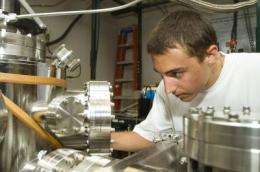Building mental muscles through theoretical physics

A grant from the D. J. Angus-Scientech Educational Foundation has made it possible for a student from a suburban Indianapolis high school to co-author, along with his mentor and two other scientists, a theoretical physics study in a top tier peer-reviewed scientific journal, a paper which has been selected for rapid communication due to its importance to the field.
"It is extremely rare for a high school student to be a co-author on a physics paper. Statistics on this aren't available, but it is likely less than 1 paper in 1,000, that's one tenth of one percent of physics research papers, has a high school co-author. It is unusual even for upper class undergraduates to publish in physics. This is usually the province of graduate students and faculty," said Andrew Gavrin, Ph.D., chairman of the Department of Physics at the School of Science at Indiana University - Purdue University Indianapolis.
Published in Physical Review A, "Robust and Fragile PT-symmetric Phases in a Tight-binding Chain," was authored by Guerin Catholic High School senior Mark Babbey, along with IUPUI graduate student Derek Scott, Avadh Saxena, Ph.D. of Los Alamos National Laboratory and IUPUI assistant professor of physics Yogesh Joglekar, Ph.D., who led the study and mentored Babbey.
"Although theoretical physics research has traditionally been beyond the capability of beginning physics students and usually not tackled until the graduate level, the advent of new mathematical computing software with good user interfaces has enabled bright high-school and undergraduate students to carry out original research," said Joglekar, who was the recipient of a 2009 Indiana University Trustee's Teaching Award.
Joglekar studied the properties of quantum particles that hop from site to site on a chain in which one site can absorb them and another can emit them, technically known as a PT-symmetric chain. He uses a simplified analogy of a canal to explain the research.
A canal without tributaries has a constant flow of water. If a canal has one tributary carrying water in and one distributary carrying water out of it, the water flow in the canal will depend upon the distance between them and their sizes. With Babbey's assistance on the mathematical facets of the problem, Joglekar looked for the critical values of the tributary size and distance, below which the new system (a canal with a tributary and distributary) functions as the old one (just a canal).
With only a high-school level mathematical background, Babbey developed a MATLAB code under Joglekar's mentorship. Together they came up with a wide "U" shaped phase-diagram that, in the canal analogy, showed the relation between the constant-flow region and the distance between the tributary and the distributary. This diagram spurred further interest in and enabled theoretical analysis of the PT-symmetric chain problem.
"We constructed a new model with properties that had not been previously explored. Although we didn't do this with a practical application in mind, a possible application might include novel optical or electrical devices," said Joglekar. "Going back to the canal analogy, and to oversimplify, we were not just calculating water flow, we were also calculating a variety of flow characteristics such as the water velocities at the inlet and outlet."
"Although I only had one year of high-school physics and had to learn a lot of math on the fly over the summer to do the work, it was an amazing experience and I couldn't have asked for a better opportunity. Working in a real lab, on a real project that had never been attempted before sparked my interest. This wasn't a textbook lab exercise that every other physics student had done before; this was research. Both graduate student Derek Scott, who helped me understand the math and checked my work, and Dr. Joglekar, who patiently explained to me the concepts and the importance of what we were doing, were great mentors," said Babbey, whose high school is located in Noblesville, Ind.
Provided by Indiana University School of Medicine















